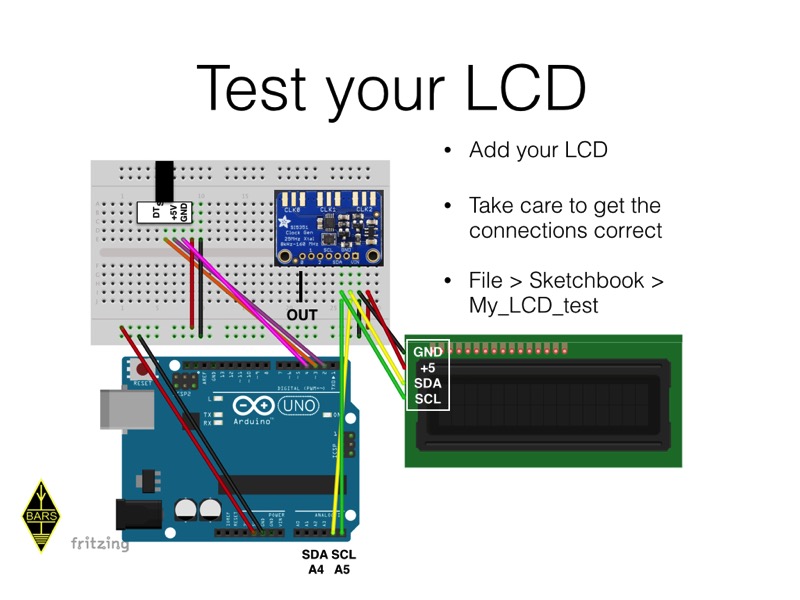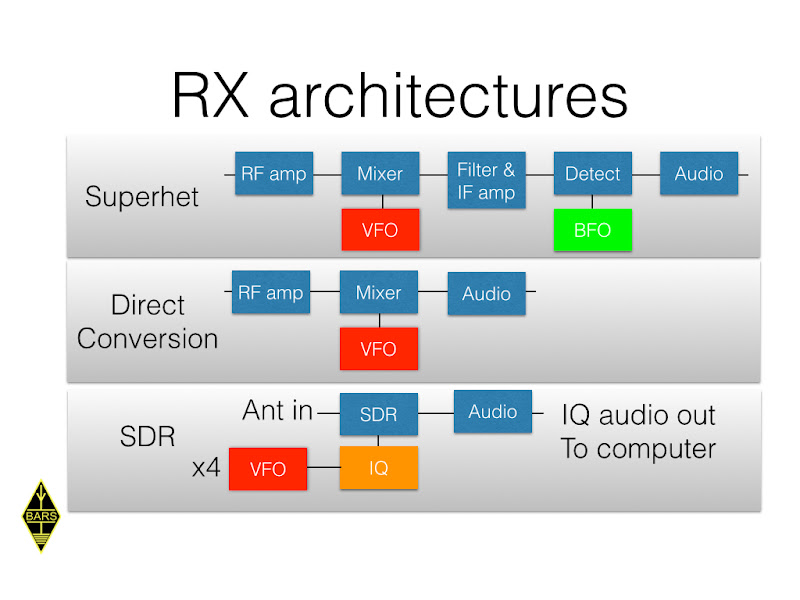The 4th Concept session covers the prototyping of a VFO with Rotary Encoder tuning and LCD frequency display.

This rotary encoder has 20 steps for each rotation, at each step the signal outputs change as shown, changes depend on the direction the encoder is turned. A library "Rotate.h" sorts out the changes and reports the result.

This is the wiring diagram. The first sketch used is called My_VFO_ROTARY, this displays the VFO frequency on the Monitor as you turn the Encoder. It changes in fixed 100Hz steps - very simple.
// My_VFO_ROTARY controls the freq by rotary encoder, freq display on monitor
// button changes band
// Si5351 I2C bus
// SDA = A4
// SCL = A5
// LCD I2C bus
// SDA = A4
// SCL = A5
// rotary encoder pins
// DT = 2
// CLK = 3
// SW = 4
// I2C, Si5351, LCD and rotary Encoder libraries
#include "Wire.h"
#include "si5351.h"
#include "Rotary.h"
// tuning freq STEPS (cHz), 100Hz
#define STEPS 10000
// rotary Encoder pins 2 & 3 (DT & CLK), band change pin 4 (SW)
#define DT 2
#define CLK 3
#define SW 4
// dds object
Si5351 dds;
// rotary Encoder object
Rotary rot = Rotary(DT, CLK);
// start frequencies (cHz), band names
uint32_t freqStart[3] = {
710000000, 1014000000, 1410000000
};
// band, freq (cHz)
byte band = 0;
uint32_t freq = freqStart[band];
void setup() {
Serial.begin(9600);
// init dds si5351 module, "0" = default 25MHz XTAL
dds.init(SI5351_CRYSTAL_LOAD_8PF, 0);
// set 8mA output drive
dds.drive_strength(SI5351_CLK0, SI5351_DRIVE_8MA);
// enable VFO output CLK0, disable CLK1 & 2
dds.output_enable(SI5351_CLK0, 1);
dds.output_enable(SI5351_CLK1, 0);
dds.output_enable(SI5351_CLK2, 0);
// encoder, button, RX, TX, band and XMIT pins
pinMode(DT, INPUT_PULLUP);
pinMode(CLK, INPUT_PULLUP);
pinMode(SW, INPUT_PULLUP);
freqOut(freq); // output freq
dispFreq(freq); // display freq
}
void loop() {
// tune?
if (tune()) {
freqOut(freq);
dispFreq(freq);
}
// band?
if (button()) {
freq = freqStart[band];
freqOut(freq);
dispFreq(freq);
}
}
// tune?
bool tune() {
unsigned char dir; // tuning direction CW/CCW
// turned?
dir = rot.process(); // read encoder
if (dir != DIR_NONE) { // turned?
if (dir == DIR_CW) freq += STEPS; // increment freq +/- STEPS
if (dir == DIR_CCW) freq -= STEPS;
return true;
}
return false;
}
// band?
bool button() {
if (digitalRead(SW) == LOW) { // button pressed?
while (!digitalRead(SW)); // wait for release
if (band == 2) band = 0; // loop
else band++;
return true;
}
return false;
}
// frequency (in cHz) for VFO, on CLK0
void freqOut(uint32_t f) {
dds.set_freq(f, 0ULL, SI5351_CLK0); // converted to cHz
}
// display freq in cHz
void dispFreq(uint32_t f) {
Serial.print("My VFO = ");
Serial.print((float)f / 100000, 1); // convert to float for print function
Serial.println(" kHz");
}Next we add the LCD display, this connects via an I2C bus connection (note some displays seem to have address 0x0x27 others 0x3F, if one doesn't work try the other).

Wire up your LCD


This is the code for tuning with the encoder
// My_VFO_ROTARY_LCD controls the freq by rotary encoder, freq display on LCD
// button changes band
// Si5351 I2C bus
// SDA = A4
// SCL = A5
// LCD I2C bus
// SDA = A4
// SCL = A5
// rotary encoder pins
// DT = 2
// CLK = 3
// SW = 4
// I2C, Si5351, LCD and rotary Encoder libraries
#include "Wire.h"
#include "si5351.h"
#include "Rotary.h"
#include "LiquidCrystal_I2C.h"
// tuning freq STEPS (cHz), 100Hz
#define STEPS 10000
// rotary Encoder pins 2 & 3 (DT & CLK), band change pin 4 (SW)
#define DT 2
#define CLK 3
#define SW 4
// dds object
Si5351 dds;
// rotary Encoder object
Rotary rot = Rotary(DT, CLK);
// lcd object
LiquidCrystal_I2C lcd(0x27, 16, 2);
// start frequencies (cHz), band names
uint32_t freqStart[3] = {
710000000, 1014000000, 1410000000};
// band, freq (cHz)
byte band = 0;
uint32_t freq = freqStart[band];
void setup() {
// init LCD & backlight on
lcd.init();
lcd.backlight();
// init dds si5351 module, "0" = default 25MHz XTAL
dds.init(SI5351_CRYSTAL_LOAD_8PF, 0);
// set 8mA output drive
dds.drive_strength(SI5351_CLK0, SI5351_DRIVE_8MA);
// enable VFO output CLK0, disable CLK1 & 2
dds.output_enable(SI5351_CLK0, 1);
dds.output_enable(SI5351_CLK1, 0);
dds.output_enable(SI5351_CLK2, 0);
// encoder, button, RX, TX, band and XMIT pins
pinMode(DT, INPUT_PULLUP);
pinMode(CLK, INPUT_PULLUP);
pinMode(SW, INPUT_PULLUP);
freqOut(freq); // output freq
dispFreq(freq); // display freq
}
void loop() {
// tune?
if (tune()) {
freqOut(freq);
dispFreq(freq);
}
// band?
if (button()) {
freq = freqStart[band];
freqOut(freq);
dispFreq(freq);
}
}
// tune?
bool tune() {
unsigned char dir; // tuning direction CW/CCW
// turned?
dir = rot.process(); // read encoder
if (dir != DIR_NONE) { // turned?
if (dir == DIR_CW) freq += STEPS; // increment freq +/- STEPS
if (dir == DIR_CCW) freq -= STEPS;
return true;
}
return false;
}
// band?
bool button() {
if (digitalRead(SW) == LOW) { // button pressed?
while (!digitalRead(SW)); // wait for release
if (band == 2) band = 0; // loop
else band++;
return true;
}
return false;
}
// frequency (in cHz) for VFO, on CLK0
void freqOut(uint32_t f) {
dds.set_freq(f, 0ULL, SI5351_CLK0); // converted to cHz
}
// display freq in cHz
void dispFreq(uint32_t f) {
lcd.setCursor(0, 0);
lcd.print("VFO ");
lcd.setCursor(4, 0);
lcd.print((float)f / 100000, 1); // convert to float for print function
lcd.setCursor(13, 0);
lcd.print("kHz");
}In a future session we will be building a VFO PCB shield. Some tools are needed for this














